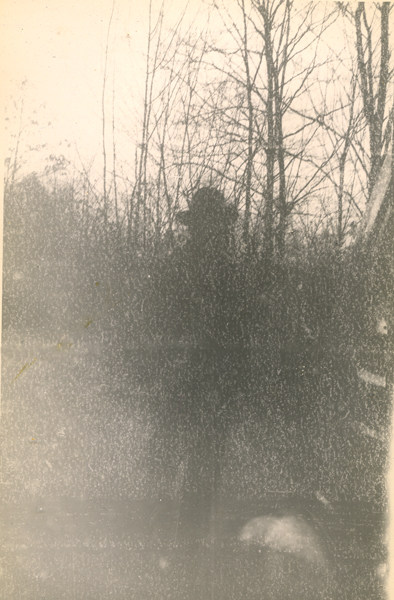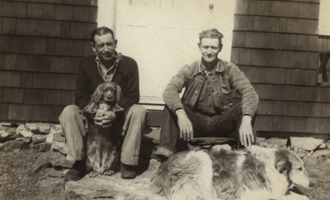A Lost World…
Some time in the 1980s my father, Sonny Jennings, toured the New Hampshire Farm Museum with me. As we walked through the exhibits, he pointed out one implement after another, describing the specific use it had. After a bit I asked him how it felt to see the stuff he grew up with in a museum exhibit. He grinned “Kind of a kick in the butt.”
There’s a tremendous amount of knowledge and skill that vanished with the last of the farmers who peopled these hills. There is no call for these labor-intensive skills, and I doubt any of these old fellows would turn up their noses at modern equipment. On the other hand, I recently watched an actor handling a scythe in a film. It was an adequate representation; but only reminded me of the beauty of real thing: an elegant, clean sweep, an almost musical rhythm as the stalks cascaded down behind.
Dialect
Some bit of reading for this project mentioned Vesta Dwy, wife of Hjalmer Erickson, an elderly couple who lived across Kent Hollow Road from my grandmother. I never knew her name was Vesta: I only heard her addressed as Vestie. The district around Davis Road and Richards Road west of Spectacle Lake was called “Bromica,” which was pronounced “BROM-a-kee.” Aunt Jnet’s unused first name was Desdemona, with the same long “e” sound. When my grandmother would to try and quell the cacophony of barking dogs, she would shout: “Hark!”
There was sometimes an up-and-down, almost singsong quality to some of the Seger speech. I’ve been ransacking the Internet looking for parallels without success.
I wonder whether accents were a lot more parochial than even the linguists classified. I recall hearing a faint oi-oi-oi sound in the speech of some of my high school classmates from Cornwall, ten miles up the river, like a relict of the English West Country… (think of talking like a pirate…) Can anyone confirm my recollection now, forty years on?
For Real?
I had my doubts when I saw this document. Marge Smith of the Kent Historical Society offered some info and Ellen Ravens-Seger, Roscoe’s granddaughter, provided more information.

I had a framed certificate from this same society hanging over my desk in our old office. It's packed away now, but for many years I enjoyed people's reaction to it. Many hilarious comments.
But horse thievery was serious business in the old days. I took our certificate to Kent Center School once and asked the 5th grade class there what they thought about it. Because we were talking about bridges and transportation, they fairly quickly made the connection. Before the automobile era, there were more bridges across the Housatonic. Why? Because horses move more slowly than cars, and therefore one wouldn't want to spend all day driving down Skiff Mt, down to the center of town, across the current bridge and all the way back up Rte 7 to get to Kent Falls, for example. The round trip journey would take all day.
So, then the discussion led to who had horses. When it dawned on the formidable little 10 year old brains (and 5th graders DO scare me, but that's another subject), that everyone had horses, plural, to do the work around the farm and to carry them wherever they need to go, they began to understand why one might need help in recovering a stolen horse. I told them to look for the VIN# on the windshield of their car and think about why that was there. Then to think about how hard it would be to retrieve a stolen horse that didn't have a license plate or a VIN#. You'd need to pretty good detective help, especially since you might not have a lot of spare time from your farm to go all around the country side snooping into barns and pastures trying to find your lost horse. So you all banded together to help each other. You all became Horse Thief Detectives! The kids just loved the story, and it has become a really good teaching tool to get them to think about how different life was before cars and trucks came along.
Click here for a New York Times article from 1888.
“Winter Shakers”

There were a lot of men who worked at the Seger farm over the years. The names of some of the Templeton brothers and Tinker Hall came up in conversation. Photos of others, including Bill Sullivan, are included elsewhere. Some men boarded at the farm; others, neighbors, worked as needed. The back of Frank’s diary tallies payments to his older children, as well as others, for day work.
In the later years when Jim and Lucy owned the farm, too many of the anecdotes about regulars at the farm involve inebriation. Annie Jennings recalled being summoned regularly by Tink Hall with a call of “Girl! Girl!” to walk behind him and push him up the hill to his house on his unsteady legs.
Years later, my father was reading about the Shaker communities. Families were known to convert to the Shaker religion in the autumn, but change their minds in the spring, when life on the outside was a little less harsh. The Shakers referred to them as “Winter Shakers.” Sonny chuckled as he recounted this and said, “We had a lot of those on the farm.”
Farm Hands
Frank’s diary mentions a number of regular hands, one of whom, Bill Read, he writes of rather dismissively. Seems after a stint of competent, heavy work, Wild Bill would disappear and drink off his wages. (June 24, 1915: “Bill hung his old coat on the line at noon then went up to Ed Halls to finish his Drunk…”) Not uncommon. The work was hard and the demand was more for muscle than skill. Frank paid Bill a dollar a day, but kept a tally of deductions for, among other items, tobacco, a cash advance, a hat, milk, bread, shoes, “overhauls,” and shirts that reduced his pay in from $15.00 to $8.75.
Two of Heman’s Templeton stepsons worked at times for Jim Jennings. There are some very nasty stories that center around Jimmy Templeton, including a struggle for a knife around the kitchen table and a spectacularly unsuccessful attempt to sneak into the bed of and have sex with his teenage cousin, who didn’t appreciate the attention and nearly murdered him.
(Their brother William (Bud) Templeton seems to have not shared the family drinking problem and was active and respected in the community. He is noted as a mail carrier in Francelia Johnson’s compendium, and is seen in photos in a social setting at the farm with the Galskis.)
George Templeton was a good man around horses, slept in the barns and drank all he could get. He worked more for Uncle Jim than my Father and spent his later years working for Millard Stuart where he lived in the office at the entrance to the upper level of the barn where the horses were kept; he was found dead one morning.
Jimmy was born in 1901, same age as my Father and was more of a periodic drunk than George but a verbally abusive one who would stay drunk for a few days at a time. Nice hardworking man when he was sober with a good sense of humor. Jimmy and George were in their teens when Heman married their mother. Jimmy had a lingering resentment for whatever reason. Jimmy did like my Mother, but then, everybody did. Jimmy spent his later days in Fairfield Hills Psychiatric Hospital after drinking radiator alcohol.
Walter Jennings would not tolerate the Templetons on his farm. My father Sonny Jennings remembered Doc Jordan with some affection and bemusement. He never said anything complimentary about Jimmy Templeton.
Doc Jordan
Frederick “Doc” Jordan was a WWI veteran who suffered from being “shell shocked,” who always shook to some degree. He worked for my Father for years. I remember him as a quiet man who read pulp westerns at night and helped with all the lighter chores. He painted my first bicycle which I got for a present after an appendectomy about 11 yrs. old.
Doc’s sister came to visit him once a year, usually in October which was probably a foliage trip with visit combined. They would sit outside in her chauffer driven Packard and talk for awhile. Doc would always clean up and dress in his best clothes before she came. Why she didn’t come in and whether she was invited in remains a mystery to me. I always liked Doc. He got the nickname from recommending a remedy that cured somebody's horse.
A bit more on Tinker Hall
My father, Sonny Jennings, remembered that Tink brewed beer, but didn’t clean the yeast residue out of the bottom of the empty bottles when he made a batch. Evidently he thought it helped. No idea if anyone else drank this stuff.
You can see his humor and sense of mischief in the following anecdote related by Charles (Chase) Seger to his daughter. While I never met Chase, Uncle Roscoe got as far away from backwoods farm life as he could, and I can imagine the shock that Tink Hall afforded the young Chase. Maybe Roscoe offered it as a “Scared Straight” encounter. For those of us who aren’t familiar with the black art of cider making, apples were crushed, the juice strained and funneled into tightly-closed barrels with a spigot at the bottom. Unless Tink managed to wobble home with a bucket of cider, I suspect the cat remark was for the benefit of his city-slicker visitors…
When my father (Charles Chase Seger) was 6, he and his father (Roscoe Seger) went to Tinker Hall’s house. Tinker offered them some cider. Would you like some cider? I have a big barrel full.” Asked if it was any good, Tinker replied, “Well, the cat fell in it last night, and it didn’t hurt the cat any.”
I remember Tink and going over to his shack with Annie and Arnie. It wasn’t a place where you would want to sit for a meal. In a child’s memory I sense he enjoyed entertaining children.
Tink wore a well defined path from his shack next to Henry and Ella Thorp’s place (Tim Williams built his house on the property) to Lucy’s kitchen. He usually made more than one round trip daily. Being a relative and being adept at sharpening tools and probably other odd jobs, I’m sure he fit right in with daily farm life. After his death Fred Munson lived in the shack for years.




